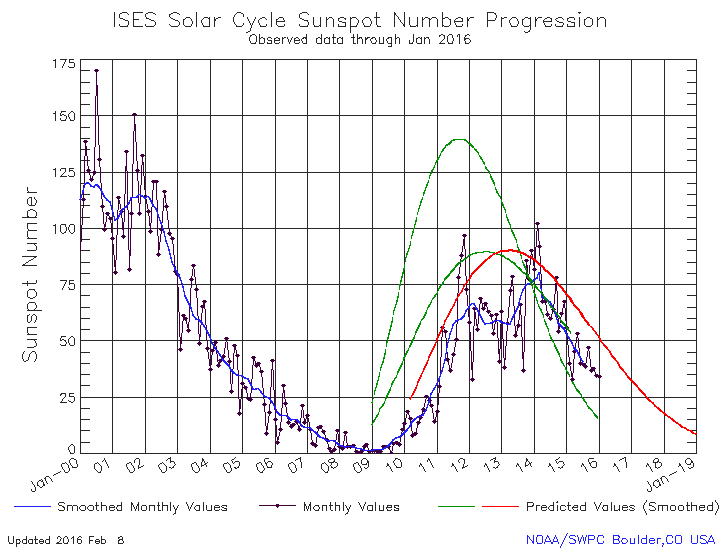The long decline to solar minimum
On Monday NOAA released its monthly update of the solar cycle, showing the Sun’s sunspot activity in January. As I have done every month since 2010, I am posting it here with annotations to give it context.
What strikes me about this month’s continuing and steady decline in sunspots is how much it illustrates the long and steady nature of the ramp down to solar minimum, even for cycles that are very active. If you look at the ramp down during the previous solar cycle on the graph below the fold, it took four full years to reach solar minimum from a comparable sunspot level to what we have today.

The graph above has been modified to show the predictions of the solar science community. The green curves show the community’s two original predictions from April 2007, with half the scientists predicting a very strong maximum and half predicting a weak one. The red curve is their revised May 2009 prediction.
It is presently seven years since that last solar minimum. If it takes four more years to reach our next solar minimum, it will mean that this solar cycle was exactly 11 years long, the average length for all solar cycles since scientists began tracking them in the 1700s. What makes that interesting is that, according to the data, a weak solar maximum (as we have just experienced) usually corresponds to a longer overall cycle. At the moment at least that does not appear to be where we are heading. If the ramp down is comparable to last solar cycle, this cycle will last about the normal length of time, while producing far fewer sunspots than predicted.
What does this mean? Don’t ask me. For one thing, the ramp down this time might take much longer than the last ramp down, so the cycle itself might end up much longer. Or it might not. It simply is too early to tell.
On Christmas Eve 1968 three Americans became the first humans to visit another world. What they did to celebrate was unexpected and profound, and will be remembered throughout all human history. Genesis: the Story of Apollo 8, Robert Zimmerman's classic history of humanity's first journey to another world, tells that story, and it is now available as both an ebook and an audiobook, both with a foreword by Valerie Anders and a new introduction by Robert Zimmerman.
The print edition can be purchased at Amazon or from any other book seller. If you want an autographed copy the price is $60 for the hardback and $45 for the paperback, plus $8 shipping for each. Go here for purchasing details. The ebook is available everywhere for $5.99 (before discount) at amazon, or direct from my ebook publisher, ebookit. If you buy it from ebookit you don't support the big tech companies and the author gets a bigger cut much sooner.
The audiobook is also available at all these vendors, and is also free with a 30-day trial membership to Audible.
"Not simply about one mission, [Genesis] is also the history of America's quest for the moon... Zimmerman has done a masterful job of tying disparate events together into a solid account of one of America's greatest human triumphs."--San Antonio Express-News


What is, if there is any, the measured decrease in solar energy output as it relates to the diminishing of sun spot activity?
The total irradiance drop is very small, about 0.01 degrees Fahrenheit, not enough to cause the cooling that has occurred in the past. This number however is what has been measured since 1978, when we finally could get good numbers above the atmosphere, so it only records changes during normal solar cycles. What happened during the Maunder Minimum in the 1600s remains very uncertain.
Cotour,
There is a hypothesis that galactic cosmic rays (GCR) striking the Earth’s atmosphere contribute to the formation of clouds, and more clouds means less solar heating. The hypothesis suggests that when the sun is active (more sun spots) then the solar magnetic field prevents GCRs from reaching the Earth, slightly fewer clouds form, and the Earth warms. The “little ice age” of the middle of the last millennium sort of corresponds to the Maunder Minimum of no observed sun spots.
This page suggests that GCRs (or the lack thereof) are not a major contributor to the current apparent global warming (can we trust the climatologists anymore?).
https://www.skepticalscience.com/print.php?r=277
On the other hand, some research suggests that sun cycles have a greater effect on Earth’s climate or weather patterns than suggested by the 0.01F change that Robert reported.
http://www.universetoday.com/38454/researchers-say-sun-cycle-alters-earths-climate/
Rhetorical question: How does the strength of a cycle affects this effect?
Burt Rutan takes on “global warming”, very comprehensive and informative lecture basically, if you have the interest and time.
https://youtu.be/jPP7P43wulg